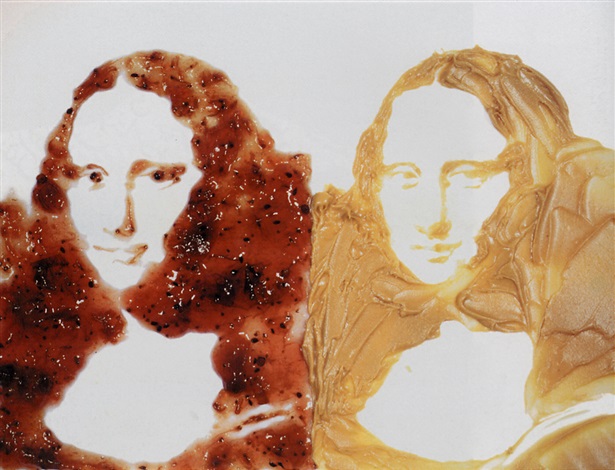Sticks & Stones: Ink
In our series Sticks & Stones, we take a deep dive into medium. Each installment features one of art history’s most significant materials—its history, evolution, and unusual uses. (See past installments.) This week’s medium is ink (explore the playlist).
Does the phrase “medium is message” ring a bell? If you’ve ever taken an art class, there’s a good chance you’ve heard it before. The saying is a common one, repeated endlessly to young artists as a reminder that the first decision they make when starting a new artwork—choosing a material—is usually the most important. Take the Mona Lisa, for instance; Da Vinci painted the solemn and iconic masterpiece in oil paint. His Mona Lisa’s half smile would leave a fundamentally different impression on viewers, however, had it been drawn in colored pencil—or in peanut butter and jelly, as contemporary artist Vik Muniz demonstrated with his comical 1999 piece, Double Mona Lisa (Peanut butter and jelly).

Every material has character, formed not just by the history of objects made from it, but the types of physical marks that can be made on or with it. Despite each medium having strong ties to the natural resources and aesthetic traditions of the place they originated from, their long, rich histories of use in art often allow them to overcome the limitations of geographical location, culture, and style.
It seems natural to start an exploration into the world of artistic mediums with one of the oldest and most versatile in the world: ink. Pared down to its simplest formula, ink is extremely easy to create. A basic version can be concocted from powdered carbonized materials mixed with water; wood charcoal and charred animal bones are two common examples. Although modern ink has many more ingredients, the old recipe is surprisingly effective (as well as resilient), and is the cornerstone of many of the oldest surviving artworks.
Ink can be used with an enormous range of different tools, making it an accessible medium for artists of all skill sets and disciplines. Ink’s water base allows it to flow easily for rapid sketches and gestural lines, as well as enabling it to dry quickly into crisp marks that can’t be smudged or erased. Unlike other popular mediums like oil paint, watercolor, or graphite, ink marks can be made with anything from an etching plate to a thumb, and still retain a crisp integrity of form, line, and edge.
In early Asian cultures, ink was thought of as a paint and applied in brushstrokes with animal-hair brushes. In contrast, European and Indian artists used ink with quills (and later, in pens) as a drawing and writing material. By diluting ink with water, Japanese and Chinese artists were able to create light background washes that could then be painted over with layers of darker, thinner lines. This layering method was used to create the ephemeral landscape masterpieces of the Chinese Literati and Japanese Sumi-e. Paintings such as Hasegawa Tōhaku’s Pine Trees showcase the evocative and meditative way artists were able to use ink to portray delicate atmospheres as well as gestural, definitive figures in a single piece.
In Chinese culture, these intricate ink landscape paintings were intended as metaphors for the path to spiritual enlightenment, and as mental extensions of the learned literati scholars who created them. Literati painters strove for expressive personal style and spontaneity above realism, making ink the perfect medium for capturing, in immutable marks, every tiny movement of their hands as they worked. Even things that could have been considered mistakes were embraced for the energy that they added to the art—take, for instance, the work of Bada Shanren. Rather than fighting against his ink’s occasional blotting, he accepted the natural imperfections that came with working in the medium, and as result was celebrated as a master painter of his time.
Printmaking was invented in China in 105 AD, at around the same time as the invention of paper. One of the simplest and earliest kinds of print to emerge was woodblock. The prints were created by ‘inking’ a carved wooden surface, and using pressure to create an impression on paper, leaving behind the ink image. Woodblock printing reached its apex in the Ukiyo-e works of the Edo period, with pieces such as Hokusai’s iconic Great Wave off Kanagawa. Many artworks from this era portrayed what was known as the “floating world,” filled with beautiful courtesans and stunning vistas. The ability to produce multiple, identical artworks from a single carved block meant that greater numbers of people were able to enjoy art in their homes than ever before.
In the 15th century, printmaking arrived to Europe and blossomed into a wide family of different techniques and practices. Many of Europe’s most famous artists cut their teeth in the print shop—Dürer and Degas being just two of countless examples. Printers throughout history and across the globe have taken full creative advantage of ink’s various properties, such as being aqueous, yet viscous enough to adhere to surfaces and keep the integrity of an impression without spreading or running. Techniques like lithography use oil to repel water-based ink from areas of a printing block intended to be white, while other methods such as drypoint are able to create minute, delicate lines by incising a metal printing plate with a thin stylus. Prints can be created through almost infinite varieties of technique—but all share the common denominator of ink.

- Click to Add to playlist
- Click to Favorite
Today, ink remains one of the most versatile and ubiquitous art materials. It traverses the boundaries of artistic practices, being used in painting, drawing, photography, printmaking and even a more recently-accepted art form: tattoos. Despite ink’s long history and extreme simplicity, in the hands of artists it continues to find beautiful new use.




